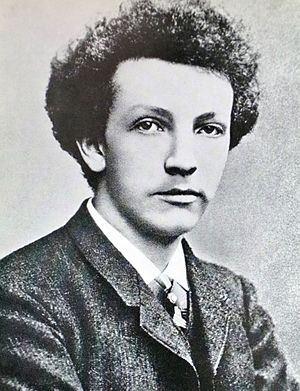Modernism (music) facts for kids

In music, modernism was a big change in how music was made. It happened around the start of the 20th century (about 1890 to 1930). Composers wanted to try new things and break away from old rules. They found new ways to use harmony (chords), melody (tunes), sounds, and rhythm.
Modernism was all about "innovation," which means creating new ideas. Many different styles of music appeared during this time. No single type of music was the most popular.
Inherent within musical modernism is the conviction that music is not a static phenomenon defined by timeless truths and classical principles, but rather something which is intrinsically historical and developmental. While belief in musical progress or in the principle of innovation is not new or unique to modernism, such values are particularly important within modernist aesthetic stances.
One example is Arnold Schoenberg. He stopped using traditional tonality (music based on a main key). Instead, he used twelve-tone music, where all 12 notes are equally important. Another example is Igor Stravinsky. He used rhythms that were not always even or symmetrical.
Most experts say musical modernism lasted from about 1890 to 1930. The time after 1930 is often called "postmodernism." Some historians think modernism ended with one of the two World Wars.
Contents
What is Musical Modernism?
Musical modernism was a time when composers wanted to make music sound very new. They felt that music should change and grow, just like the world was changing.
Breaking Away from Old Rules
Carl Dahlhaus, a music expert, said modernism was a clear "break" from the past. He felt that composers like Gustav Mahler, Richard Strauss, and Claude Debussy brought big changes. Strauss's piece Don Juan (from 1888) showed this new, exciting mood. Dahlhaus thought this "modernist music" lasted from about 1890 to 1910.
New Ways to Use Sound
Eero Tarasti described musical modernism as getting rid of traditional tonality. This means composers stopped using the usual major and minor keys. They looked for new ways to organize notes. This included atonality (no main key) or polytonalism (using many keys at once). These changes happened around the turn of the century.
Testing Music's Limits
Daniel Albright said musical modernism was about "testing the limits of aesthetic construction." This means composers pushed the boundaries of what music could be. He listed several styles that were part of modernism:
- Expressionism: Showing strong feelings.
- New Objectivity: Being more realistic and less emotional.
- Neoclassicism: Using older forms but with new sounds.
- Futurism: Focusing on speed, machines, and modern life.
Music for a New Age
Leon Botstein, a conductor, explained that composers felt music in the 20th century needed to fit the new, fast-changing world. This meant music started to show ideas from:
- Science and technology
- Industry and machines
- Big cities and many people
- Different cultures and nations
See also
 In Spanish: Música modernista para niños
In Spanish: Música modernista para niños
- List of modernist composers
- Abstractionism
- Avant-garde music
- Experimental music
- Expressionism
- Futurism
- History of music
- Neoclassicism
- Neoconservative postmodernism
- Philosophy of music

